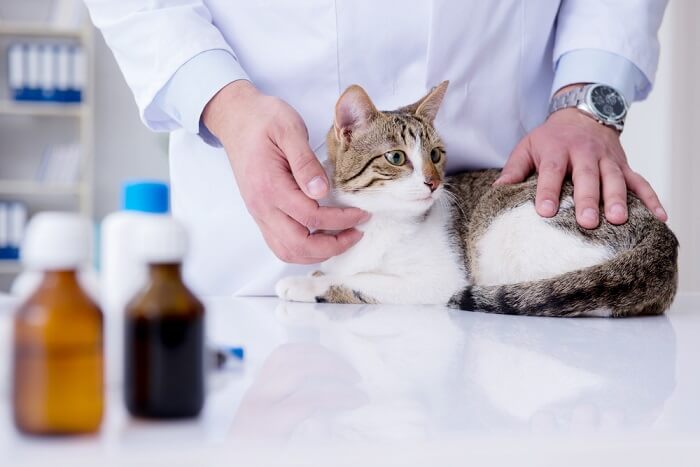
Atopica for Cats is a very specific brand of the drug cyclosporine, which is FDA-approved for use in cats. In this article, you’ll learn what Atopica for Cats is, what it’s used for, side effects and drug interactions to be aware of, and some frequently asked questions.
Atopica For Cats Overview

What Is Atopica for Cats?
Atopica is a brand name for the drug cyclosporine. Cyclosporine is a systemic immunosuppressive agent called a calcineurin inhibitor that is used to treat illnesses caused when a cat’s own immune system either directly attacks a certain body system, or becomes over-stimulated, leading to a more indirect but no less debilitating state of disease. These types of illnesses are called immune-mediated diseases.
Atopica for Cats is a very specific liquid solution form of cyclosporine that is FDA-approved to treat allergic dermatitis, a skin condition caused by the immune system’s response to allergens. Atopica may also be used for a variety of other immune-mediated diseases in an off-label manner, at a veterinarian’s discretion.
What Does Atopica Do for Cats?
Atopica for Cats is labeled for treating allergic dermatitis, also called atopic dermatitis, in cats. Commonly referred to as skin allergies, this syndrome can have several presentations, including generalized itchy skin and scratching, scabs, alopecia (hair loss), and red ulcerative lesions called eosinophilic plaques.
Cyclosporine acts directly on the part of the immune response called cell-mediated immunity. Essentially, this is the part of the immune system that does not involve antibody production, but instead the body’s direct production of T-cells to attack foreign targets like allergens.
There are other immune-mediated diseases a veterinarian may decide to use cyclosporine for in cats that don’t involve the skin. These can include diseases of blood cells like pure red cell aplasia and immune-mediated thrombocytopenia, as well as the gastrointestinal tract like inflammatory bowel disease, and the mouth as in stomatitis.
Side Effects of Atopica in Cats
Anytime we consider using a systemic immunosuppressant, we have to consider the benefits vs. the potential risks. There are several points we need to consider when starting cyclosporine.
Digestive Upset
When using cyclosporine in cats, it may be expected to see signs of digestive upset during the first month of therapy. According to the product label itself, about 35% of cats showed signs of vomiting, retching, or regurgitation. Weight loss was seen in about 20% of cats.
The good news is that these effects reportedly resolve after a couple weeks of continued therapy. Some other side effects like poor appetite, salivation, and lethargy are much less commonly reported.
Effects of Immune System Suppression
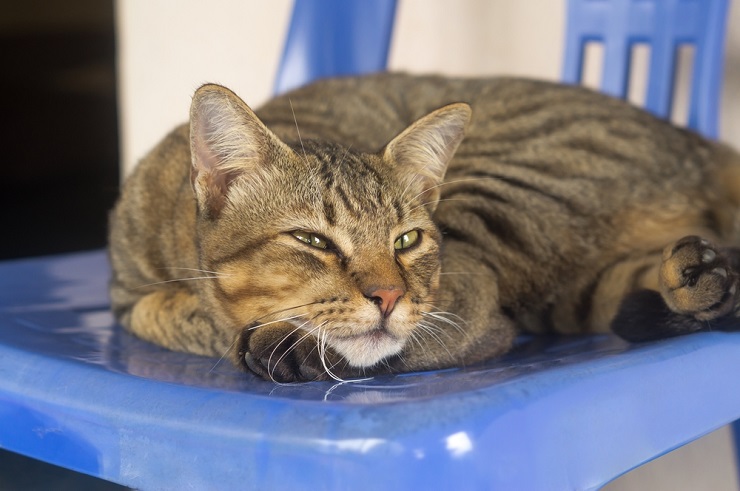
If a cat carrying toxoplasmosis is put on an immunosuppressant medication like cyclosporine, the inactive stage of the organism can become active again, causing actual disease.
Because cyclosporine suppresses the immune system, its use must be considered very carefully in light of any other health concerns a kitty has. While it can cause problems on occasion, the immune system of course is very important to general health and it can keep certain diseases in check.
Feline leukemia virus (FeLV) and feline immunodeficiency virus (FIV) are two viruses we can commonly see in the cat world that can weaken a kitty’s immune system even as it tries to keep them in check.
Suppressing the immune system further with cyclosporine use can worsen viral disease, and make a kitty more susceptible to other viral and bacterial infections that a cat with a normal immune system would easily be able to fend off. For this reason, it may be recommended to have a cat tested or retested for FeLV and FIV prior to starting Atopica long-term.
Similarly, any kitty that may have a weaker immune system for other reasons, such as an elderly cat, may also see a much higher risk of secondary infections.
Toxoplasmosis is also important to mention, as some cats can be carriers and use of cyclosporine carries a risk of it causing disease.
Toxoplasma is a protozoal organism that cats can acquire either through hunting birds and rodents or through exposure to the cysts in the environment. Once infected, most cats will only shed the organism in the stool for one period of a few days.
Cats then develop immunity to the organism, driving it into an inactive stage within the body tissues. While inactive, it is thought the organism can remain present for several years, possibly for the life of a cat. Most cats with toxoplasmosis show no signs of disease.
If a cat carrying toxoplasmosis is put on an immunosuppressant medication like cyclosporine, the inactive stage of the organism can become active again, causing actual disease.
This can pose a risk not just to a kitty, but also to her human family as well. Toxoplasmosis is the disease pregnant women need to be aware of, as it can be transmitted to people as well as to an unborn child, and is the reason a pregnant woman should avoid any exposure to the litter box for the duration of pregnancy.
It is considered very rare, but a case of a cat developing disease from toxoplasmosis after starting Atopica has been reported. Testing a cat for exposure to toxoplasmosis is possible, and while not often deemed necessary, at least for indoor cats, may be suggested by your vet depending on the circumstances.
Cell-mediated immunity is a very important component of the body’s ability to fight off cancers. Although also rare, suppressing this ability with cyclosporine could increase the risk for the development of certain cancers. To be clear, cyclosporine doesn’t cause cancer, but can allow an existing, unknown cancer to develop more readily by reducing the body’s ability to suppress it. Cyclosporine should not be used in kitties currently under therapy for known or suspected cancer.
Interactions With Medications
Lastly, cyclosporine can have interactions with a number of other medications. It’s very important to make sure your vet is aware of any other medications your kitty is taking, to reduce the risk of any possible negative effects.
While not often indicated when treating skin disease, your veterinarian may recommend lab work monitoring for your kitty when treating other immune-mediated conditions.
If you are ever concerned that your kitty may have developed side effects while using cyclosporine or if you’re concerned an overdose may have occurred, make sure to immediately contact one or more of the following for advice:
- Your veterinarian
- ASPCA Animal Poison Control Center (1-888-426-4435)
- Pet Poison Helpline (1-855-764-7661)
Atopica for Cats Dosage
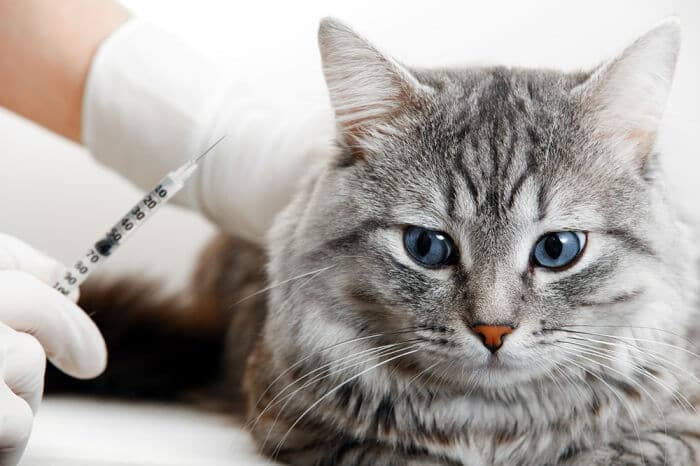
The dosage of Atopica for Cats is 7mg per kg of body weight each day.
The labeled dose for Atopica for Cats is 7 milligrams per kilogram per day or 3.2 milligrams per pound per day, and should be continued for a minimum of 4-6 weeks to determine if it is being effective.
From there, your veterinarian will typically reduce the frequency of administration, which is called tapering, to the lowest frequency that still provides the most benefits. Some cats for example, may maintain well on dosing every other day or just a couple times a week. It is very important however to only adjust a medication dose or frequency under your veterinarian’s guidance.
While cyclosporine generally can come in a couple of different dosing forms, Atopica for Cats comes in only one specific formulation as a 100 mg/ml oral solution. Because cyclosporine can present a risk to humans handling it (which we’ll discuss in the next section), the dispensing system of the bottle and oral dosing syringe are designed specifically to minimize skin exposure to the liquid.
It’s important to assemble the dispensing system correctly, using the provided packaging insert, and instructions from your vet.
How to Properly Handle Cyclosporine Products?
Although a very beneficial medication, the immunosuppressive effects of cyclosporine necessitate very careful handling by human family members administering this drug to kitties.
The dosing assembly of the bottle and syringe for Atopica for Cats is designed specifically to limit exposure of the skin to the liquid medication, however using gloves is recommended for dosing, especially if giving it directly into a kitty’s mouth vs. mixing it with some food.
The manufacturer advises washing your hands after administration but recommends not washing or rinsing the oral dosing syringe after use, to limit exposure.
Gloves should certainly be worn when giving any other forms of cyclosporine too, like other liquid formations or capsules.
Modified vs. Unmodified Cyclosporine: What’s the Difference?
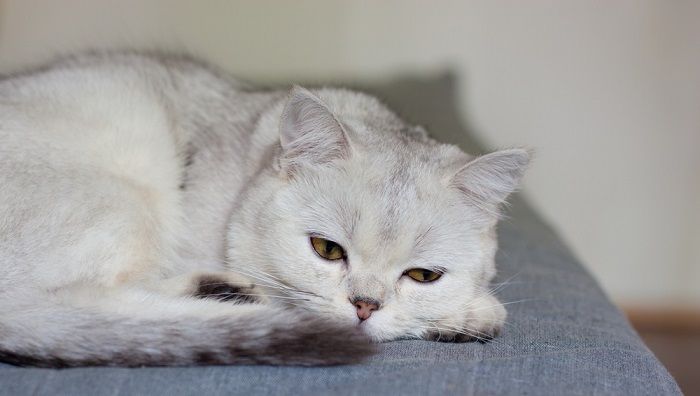
Your veterinarian will discuss the benefits and risks to Atopica’s use specifically for your kitty depending on other medications he may be on or other health concerns that may exist.
There are two general forms of cyclosporine that exist: modified and unmodified. Unmodified cyclosporine is kind of its original form, but this form is far less bioavailable and can’t be used as efficiently by the body.
The modified form is much more effective, especially in cats and dogs. It’s important to know this, because the dosing for unmodified forms of cyclosporine, like the brand Sandimmune, are not equivalent to modified forms like Atopica and Neoral.
This is especially important when looking into generic forms of cyclosporine as well as when a compounded formulation of cyclosporine may be needed.
Conclusion
Cyclosporine in the form of Atopica for Cats is a very beneficial medication. However, because it does suppress the immune system, there are many precautions that need to be taken and considered with its use.
Your veterinarian will discuss the benefits and risks to Atopica’s use specifically for your kitty depending on other medications he may be on or other health concerns that may exist.
Frequently Asked Questions
How Long Can a Cat Stay on Atopica?
Given the nature of the types of diseases Atopica is used to treat, many cats will be on this medication for a very long time, sometimes for life. It is always the goal to taper Atopica’s dosing frequency down to the lowest effective dose, to minimize potential side effects and make it as safe as possible long-term.
While there are some cases where an immunosuppressive medication’s dosing and frequency may be tapered down enough that it can be discontinued, this should not be a common expectation.
In some cases, especially if side effects are seen, other medications or therapies may be considered.
Should Atopica Be Given with Food?
While cyclosporine should be given on an empty stomach in dogs, there is reportedly no difference in absorption of the medication in cats whether it’s given with or without food. However, it is recommended that whatever way is chosen, that this method of administration is kept consistent.
When giving with food, it is recommended to administer directly onto a small amount of canned or soft food to ensure that the dose is consumed.
What does Atopica do for cats?
Atopica is an immunosuppressive medication, meaning that it reduces the immune system’s impact on the rest of the body. More specifically, it affects cell-mediated production of T-cells, which is the part of the immune system not related to antibody production.
Atopica’s use can be important when the immune system is responsible for causing active disease by either over-reacting to a stimulus, as with allergic skin disease, or when targeting a specific body system or cell line as with the platelet disorder called immune-mediated thrombocytopenia or red blood cell disorder called pure red cell aplasia.
Atopica for Cats is labeled specifically to aid in the control of feline allergic dermatitis, but may be used off-label at the discretion of a veterinarian to treat other disorders caused by the immune system.
What are the Side Effects of Atopica in Cats?
The most common side effects are related to digestive upset, like vomiting and regurgitation. Most of these signs fortunately tend to clear up on their own beyond one month of continued use.
There can be other side effects less commonly seen. As an immunosuppressive medication, cyclosporine can increase the risk for certain diseases the immune system may be normally keeping at bay, including bacterial infections, viral infections, protozoal infections like toxoplasmosis, and cancers.
Cyclosporine can also have interactions with many other medications, so it’s very important to make sure your vet is aware of other medications your kitty takes before starting Atopica for Cats.







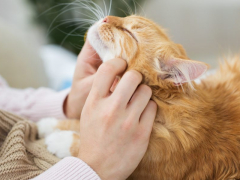
Is their something else I can give mg 16 lb cat with diabetes considering Atopica is out of stock everywhere? My cat is very sick and needs it. Can’t afford the price to compound the one place that sells it. I am a single parent of a diabetic cat, dog with congestive heart failure & a small child! PleAse help me find something to help him!
Hi Steph,
Supply chain issues have been causing shortages of many different products in recent months, which ultimately is affecting care of pets that need them. I’m very sorry to hear you and your kitty have been affected.
Cyclosporine (Atopica) is used to treat many different conditions in cats, so I may not be able to answer your question fully as I am not familiar with your kitty or the reason that he’s on Atopica.
The steroid prednisolone often makes for a reasonable way of treating certain immune conditions and can be used in the short-term if a preferred long-term medication like cyclosporine becomes unavailable.
Unfortunately though, as your kitty is a diabetic, use of prednisolone could complicate regulation and cause new problems, which is unfortunate. You may already be familiar with that problem from discussions with your vet, making prednisolone a not-so-great choice here.
If this is a skin-related disease, like atopic dermatitis, Apoquel has been used successfully in cats for a few years and you could speak to your vet further about that if applicable.
If this is a digestive condition, you could speak to your vet about the steroid budesonide, which has far less impact on the body as a whole, focusing mostly on the digestive tract, and would be less likely to interfere with diabetic regulation.
We have articles on both Apoquel and Budesonide that you could read and see if they might apply to your cat’s situation and to help open a dialogue to speak further about options with your vet.
Beyond my insight there, I couldn’t speak further on what else could be used, because it depends heavily on the medical condition. There are other immunosuppressive medications out there for other conditions that you could speak to your vet further about.
Hi there,
My cat has been on Atopica for almost 2 years. The reason is she showed low blood platelet as I saw some bruises on her skin. The vet started with steroids but that did not improve anything. Fortunately, Atopic is working now. As she got stable, we started to taper it but she showed signs of bruises again as we reached 0.1 mm from 0.5 mm per day. I remember 2 years ago, the vet asked us if she was exposed to any allergic things, but at the time I did not find any reason for her to be allergic. Recently when she showed the symptoms again, I had lily flowers at home. Do you think that my cat might have allergies to plants as I have many indoor ones? Or this is an immune disorder as she has been showing this condition for a long time now. The vet says that this is an immune disorder condition, but what if she is allergic to plants and this condition is due to being constantly in close contact with them? Not sure if the sign of low blood platelet and lily was a coincidence or not.
Hi Sarah,
Immune-mediated thrombocytopenia, which is the term for what it sounds like your kitty is being treated for, can have many underlying causes, and unfortunately, pinpointing that cause is very difficult and often never occurs.
A blood disorder resulting from an autoimmune trigger may happen shortly after the trigger or it could be weeks or months later.
Anything that stimulates the immune system could in theory lead to an inappropriate response by the immune system to attack normal cells in the body.
However, to my knowledge, a general allergy to a plant is unlikely to lead to an autoimmune blood disorder. Any kind of inhaled pollen or other allergen is more likely to lead to asthma in cats and less commonly, atopic dermatitis or skin allergies.
Of course, true lilies singularly pose a toxic risk to cats’ kidney function if they inhale the pollen or ingest any part of the plant, but to my knowledge, when this toxicity occurs, an autoimmune response is unlikely to occur, as this is not an allergic response but a toxicity.
If it’s been two years and your kitty’s signs have been controlled with Atopica (and clearly it continues to be needed) a bone marrow disorder interfering with platelet production is most likely, as has probably been discussed. The recurrence of bruising sounds more like it might have been related to the tapering down of Atopica allowing the immune disorder to resurface.
You could discuss a bone marrow biopsy with your vet, as sometimes you can get an answer in terms of an underlying cause, but given that Atopica controls your cat’s signs well and the results of a bone marrow biopsy likely wouldn’t change the treatment plan, it could be argued that an invasive test like that wouldn’t be in your cat’s best interest.
This is a question about how to read the dose in the syringe. Do you go by the bottom plastic piece? Sometimes there is air in the syringe and there will be a good amount of air between the plastic piece and the liquid. In these cases, the bottom plastic piece will be at say 10 and the liquid will be at say 6? The a topical bottle apparatus is very difficult to maneuver. I want to know which dosing is correct. I believe it’s the first one. But wanted to ask.
Hi Carolina, thanks for the question. Generally, your dose will aline with the very bottom of the plastic piece or rubber end to the plunger in the syringe. It is important for accurate dosing to remove any air you’ve got trapped in there. To do this after pulling up the volume of medication, turn the syringe so that the tip is facing up towards the ceiling. The air bubble may move its way towards the tip on its own. If it doesn’t, give it a little flick with your finger to encourage any air to float towards the tip of the syringe opening. You can also pull back a little bit on the plunger in that position to help make sure all medication collects at the bottom. When the air is all at the tip, you can push it out carefully, being sure not to expel any medication. You can then see exactly how much liquid dose you have in there without the air in the way. I hope that helps.
I need help! I accidentally gave my cat to much atopica… This is her second dose, I gave her the same amount yesterday. Should I be worried?
Hi Patty,
Generally I’d say you should be okay and hopefully you have not seen any signs of concern as long as your cat has been tolerating the Atopica okay in general. According to Plumb’s Veterinary Drug Manual, cats given up to 40mg/kg as a single overdose of cyclosporine showed no signs of ill effects. If a dose this high is given over weeks or months, intensified side effects may be seen. But if you’re giving the labeled dose of 7mg/kg to your cat and the double dose ended up being 14mg/kg, you can see that’s still well under that 40mg/kg threshold. Even with that happening two days in a row it would not appear to be a major concern.
As a tip though for anyone, this blog should be for non-urgent questions as a response may take up to 2-3 days. If something urgent or concerning occurs, make sure to direct questions to your veterinarian or a local emergency hospital. For medication overdose or toxicity concerns, you can also contact the ASPCA Poison Control Center or the Pet Poison Helpline.
My vet wants to put my cat on Atopica. He is about 15 years old. A good weight, happy, plays, eats, cuddles, doesn’t go outside much anymore. I would not have known anything was wrong with him. She said he was very healthy. But she said he should have his teeth cleaned which I thought was strange because she said he had good teeth and they even removed a couple. She said he had bumps under his tongue and had it biopsied. I believe it is eosinophilic plaques. I got the medicine and am ok with the cost but if he is happy and content can I hold off giving it to him now? I also don’t like the sound of the side effects. I am going to try and get him into hypoallergenic food instead. I bought a case of soft food but he won’t go near it so I’ll try some other brands.
Hi Mary,
I think that ultimately, the choice is yours and that it’s important to consider the costs and benefits. I always suggest to look at whether the risk of any medication or procedure may outweigh the benefits. On the flip side I also think it’s important to utilize a medication if there is a significant disease present that needs treatment. Side effects are not guaranteed, only possible, and sometimes they can be mitigated with medication dosage adjustments.
If these are eosinophilic plaques, atopica likely would help with them but as a broad immunosuppressive medication, there are potential side effects to consider and a need for extra labwork monitoring. Your vet is trying to do what is most appropriate medically, but if you don’t feel that the areas of concern are uncomfortable or causing your cat distress, it is reasonable to have that discussion about monitoring and waiting on Atopica.
It’s possible a dietary change may help, though often the underlying cause of eosinophilic lesions is not fully clear. It is possible for them to worsen and become uncomfortable, so close monitoring at least would be prudent.
Can the liquid atopica be kept in the syringe overnight? I have a hard time catching my cat to give her the medication and would like to have it ready ahead of time. Also, could I put the liquid dosage into a gelatin capsule for easier administration and freeze the gelcaps for future use?
Hi Marlene,
I wouldn’t see an issue with keeping your dose in the syringe overnight or in putting the dose into a gel capsule. But the manufacturer indicates not to refrigerate the liquid Atopica and that it should be stored at room temperature (15-25C or 59-77F). I think therefore that freezing the liquid would not be appropriate. If there might be concern that refrigerating may affect the medication, freezing and thawing certainly would.